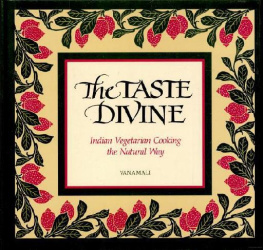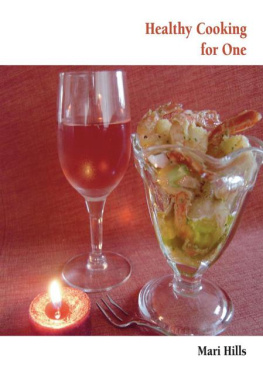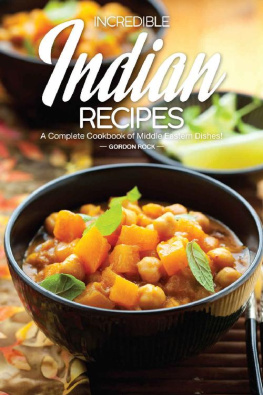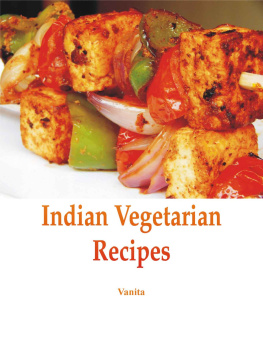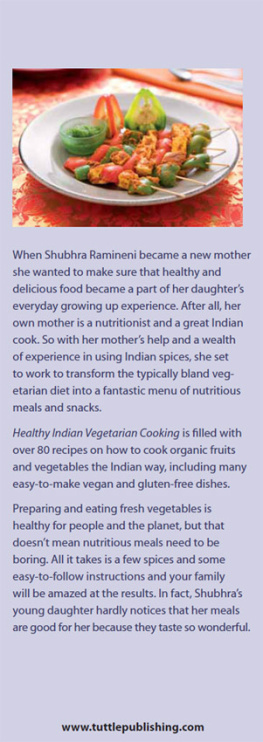Contents Introduction
What are Natural Foods? Types of Food Cooking Methods & Utensils Good Eating Habits Preparation of Essential Ingredients How to Sprout Pulses & Cereals How to Make Garam Masala Chapter One: Sadhana Juices & Shakes Chapter Two: Gokul Herbal Teas Chapter Three: Balakrishna Milks, Butter & Cream Chapter Four: Damodara Salads Chapter Five: Manamohan Salad Dressings & Sauces Chapter Six: Shyamasundara Soups Chapter Seven: Krishna Chutneys & Pickles Chapter Eight: Muralidhar Bread Chapter Nine: Chaitanya Chapathis Chapter Ten: Narayana Rice Dishes Chapter Eleven: Nanda Kumar Curries Chapter Twelve: Vishveshwara Woked Vegetables Chapter Thirteen: Poornanand Sweets & Desserts Chapter Fourteen: Vanamali Special Dishes General Glossary Glossary of Hindi Terms Vegetables Fruits Nuts Cereals & Pulses Glossary of Sanskrit Recipe Names Index General Glossary Aniseed ( saunf). This seed of the anise plant is an appetite stimulant and digestive that helps prevent flatulance. Aniseed is often served after meals. Asafoetida ( hing). A pungent digestive gum resin with medicinal properties, asafoetida is frequently used in South Indian cooking. AgarAgar (China grass or seaweed).
An extract of sea alga, agar is often used in puddings instead of gelatin. Bay Leaf ( tej patta). An aromatic herb with preservative and germicidal properties, bay leaf is used fresh or dried for flavoring curries and other dishes. Black Pepper ( kali mirch). Rich in vitamin C, black pepper is used to stimulate the heart and cure fevers and colds. It is said to be the first spice discovered by man.
Obtained from the berries of the pepper vine, black pepper can be substituted for red chilies when a milder tasting dish is desired. Cardamom ( ellaichi). This scented spice is used extensively in Indian cooking. Seed pods from the cardamom plant can be either large or small: the big black pods are used in curries and pulaus) the small green pods are used in sweet dishes. Chilies, Red or Green ( mirch). Because they are so hot, dried red chilies are rarely used in the recipes in this book.
Only the fresh tender green chilies, such as jalapeno or serrano, should be used and then only after removing the seeds, which are the hottest part. The skin contains vitamin C and lends a good flavor. Cinnamon ( dalchini). Used in stick or powdered form in curries and sweets, cinnamon is a strong germicidal spice. Cloves ( laung). These dried flower buds are used whole or in powdered form in sweets, curries, and garam masalas.
Cloves are a powerful antiseptic. Coriander ( dhania). The leaves of this herb, called cilantro, are a good source of vitamins they are used extensively in recipes in this book for garnishing and flavoring. It is an aromatic herb, similar to parsley. Its seed form is a carminative. Cumin Seeds ( jeera). Cumin Seeds ( jeera).
These seeds come from a plant belonging to the caraway family. Cumin seeds are either white or black the white ones are more commonly used in Indian cooking. These seeds are also a digestive. Curry Leaves ( meetta neem). Aromatic leaves used in South Indian curries and chutneys. Fenugreek ( methi). Fenugreek ( methi).
The green leaves are rich in vitamin C and can be added to most vegetables. The seeds are rich in iron and can be used sparingly to flavor various dishes, since they are slightly bitter. Ghee. Clarified butter. Ginger ( adruk). This light brown, gnarled root is used in making curries and especially dals. It has medicinal properties and is a carminative.
Ginger can also be dried and powdered and is used in sweets and cakes. Jaggery. Unrefined cane sugar. Jalapeno. See Chilies. Legumes. Generic term for podbearing plants, like peas. Mace ( javitri). Sold as blades or in powdered form, this spice is composed of the outer membrane of the nutmeg seed.
It is used as a seasoning in curries and rice dishes. Mango Powder ( amchoor). A tancolored powder used in chutneys and curries instead of tamarind to impart a sour taste. Mint ( podina). An aromatic herb used in chutneys and curries, mint is also good for herbal teas. Mustard Seeds ( sarson ka beeja).
These tiny yellow or black balls are rich in manganese and vitamin D. Pungent in flavor, they are used in most South Indian curries. Nutmeg ( jaiphal). A digestive agent, nutmeg is used to flavor savories and puddings it helps reduce flatulence. Parsley ( ajmooda ka patta). Rose ( gulab). Rose ( gulab).
Both the red and pink variety have a good fragrance and can be used in making teas and flavoring certain types of puddings. Either fresh or dried leaves can be used. Saffron ( kesar). The king of spices and perhaps the most expensive, saffron, with its delicate orange color, lends a unique flavor to pulaus and puddings. Saffron strands are the dried stigmata of the saffron plant, which grows in abundance in Kashmir. Sesame Seeds ( til). Sesame Seeds ( til).
These extremely nutritious seeds can be used as flavoring or made into butter. Turmeric ( haldi). This root spice, which has a distinct yellow color, comes in powder form. It is widely used in many Indian dishes it is also known for its antibacterial action. Glossary of Hindi Terms Vegetables English Hindi Ash gourd Petta Bell Pepper Simla Mirch Beetroot Chukandar Bottle gourd Louki Eggplant Baingan Cabbage Bandhgobhi Carrot Gajar Cauliflower Gobhi Coriander Har dhania Cucumber Kheera (or Kakri) Green Beans Sem Fenugreek Methi Green Peas Matar Okra Bhindi Onions Pyaz Potato Aloo Pumpkin Kaddu White radish Mooli Snake gourd Chichinda Spinach Palak Scallion Hari pyaz Sweet corn Makkai Turnip Shalgam Tomato Tamatar Yam Suran Fruits English Hindi Apple Seb Apricot Khumani Banana Kela Date Khejoor Fig Angeer Grapes Angoor Guava Amrood Lemon Galgal Lime Nimbu Mango Aam Orange, Mandarin Santara Sunkist Malta Papaya Papita Peach Aroo Pear Naspati Pineapple Ananas Plum Ploom Pomegranate Anar Raisins Kishmish Watermelon Tarbuz Nuts Almonds Badaam Cashew Nut Kaju Coconut Nariyal Peanut Moongfalli Pistachio Pista Walnut Akhroot The bodies of beings are born from food, food is produced from rain, rain comes from sacrifice, and sacrifice is born of action. BHAGAVAD GITA, CHAPTER 3, VERSE 14 Cereals & Pulses English Hindi Barley Jawar Split Chickpea Chana dal Black garam Urad dal Chickpea flour Besan Corn Makkai Cornflour Makkai ki atta Red kidney beans Rajma Dried chickpeas Kabuli chana Dried split moong beans Moong dal Lentil Masoor dal Millet Bajra Rice Chawal Rice, longgrain Basmati Semolina Sooji Dried pigeon peas Toovar dal Wheat Gehun Whole wheat flour Atta Whole green gram Sabat moong dal Glossary of Sanskrit Recipe Names All recipes have been given Sanskrit names that have a special spiritual significance.
The approximate meanings are given below. The meanings are listedin order of recipe number, not alphabetically. Chapter titles are in bold type. Sadhana Spiritual training and practice 1 Archana Offering to God 2 Pooja Ritualized form of worship 3 Aradhana Worship and adoration of God 4 Samyama Concentration and directing of the mind to achieve a yogic state 5 Niyama Restraint of the mind 6 Asana Yogic posture of the body 7 Yoga Any activity leading to union with the Supreme 8 Pranayama Yogic method of breath control 9 Dharana Contemplation 10 Japa Repetition of a mantra, mentally or on a rosary 11 Dhyana Meditation 12 Brahmacharya Sexual restraint and purity 13
Next page
